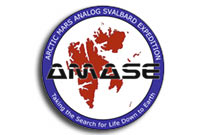NASA Arctic Mars Analog Svalbard Expedition Field Report (AMASE 2007): Last Day in Bockfjorden

08.18.07
Today was our last day in Bockfjorden. The first scheduled activity was to get everyone out to the first rover field test site so those of us hidden in the darkened SOWG room could see how inaccurate our interpretations of the rover images really were. To me, this was the most fun part of the exercise. In reality, the rover site was much steeper than we had imaged. Scale can be completely lost without any of those commonly unnoticed scale markers we usually have on Earth… say… oh… plants. The rover site turned out to be much steeper and smaller than any of us had predicted.
After this insightful experience we split into three groups. One went back to the boat, one went up to sample the ice caves and one hiked all the way to the top of Sverrefjell to begin a 25m transect sampling of weathered olivine and soil down the volcano. I was part of this latter group as was Paulo, a JPL engineer on the Cliffbot rover team. Paulo had his first day off the boat only two days before and seemed to enjoy being out again. As Jen, Hans, Marilyn and I collected samples, Paulo was one of the extras who joined us to help collect. It was fun having him along and so I thought I’d have him share some of reflections on the experience.
> From Paulo:
Being on top of Sverrefjell was an awesome sight, being surrounded by pointed snowcapped peaks all around, deep fjords below carved out by years of glacier activity, and our tiny blue ship, the Lance, resting in Bockfjord far off in the distance behind a layer of fog and snow. The wind was frigid and crisp, and filled with snowflakes that lightly prickled your face. It felt as we were on top of the world; and then we began our steep decent down the volcano. Our mission- collect geological and biological samples every 25 m of altitude. With GPS in hand, we skied down the screen-covered slopes, searching for outcrops and marking coordinates for each of our sample sites.
Being a robotics engineer from JPL, I had gotten used to digging for rock samples through computer control of a robotic arm. However, this time around, I had the chance to take on the role of a real geologist. Armed with a hammer, I swung away at an outcrop, breaking free fresh xenoliths, collecting the green olivine crystals with foil for future analysis.
After six hours of hiking 400 meters down the hard, rocky face of Sverrefjell, we ended up on the soft, spongy tundra at the base. It was 9pm- you would never know if from the 24-hour daylight, however, our bodies’ definitely felt it being the end of a rough day and time for a break. We finally made it back to the Lance, greeted by friendly faces and ice cold drinks for everyone on the team. The transect down Sverrefjell was an adventure and experience you could only find on the arctic island of Svalbard through AMASE.
About Kirsten Fristad in her own words…
Kirsten Fristad here again. I’m privileged and excited to be back writing Notes from the Field on AMASE 07. I am a planetary scientist working in the Sample Analysis on Mars (SAM) Lab at the Goddard Space Flight Center in Greenbelt, Maryland where I have been for the last year and a half. I graduated from Macalester College in 2005 with a major in geology and core in astronomy knowing I wanted to pursue a research career in planetary science. Through summer internships with several planetary scientists, I developed a background in analyzing martian and lunar planetary remote sensing data and Mars analog field work in Alaska. Over the last year I have continued to organize the Goddard/SAM Team contribution to AMASE, conducted organic analyses of AMASE samples, designed and built new field hardware and participated in two other expeditions in Utah and the Mojave.
Following AMASE 07, I will be staying on in Norway as a Fulbright Scholar to begin graduate work at the University of Oslo. I am very much looking forward to exploring more of this beautiful country, reconnecting with the country of my ancestors and filling up on pickled herring and lefse!









